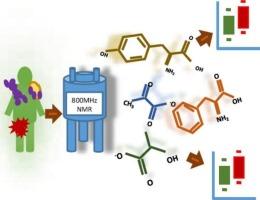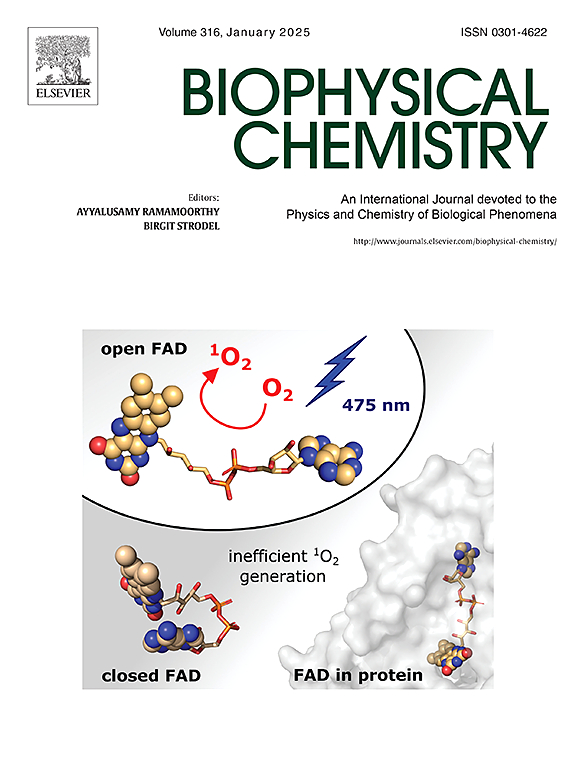脓毒症和脓毒性休克的诊断生物标志物:基于核磁共振的血清代谢组学研究
IF 2.2
3区 生物学
Q2 BIOCHEMISTRY & MOLECULAR BIOLOGY
引用次数: 0
摘要
尽管有先进的治疗手段,但脓毒症和感染性休克在重症监护病房的死亡率最高。理论表明,靶向过度炎症可以帮助治疗,但氧化应激在疾病发病机制中起主要作用。本研究旨在探讨基于核磁共振(NMR)的脓毒症和氧化应激引起的脓毒性休克的血清生物标志物。采用1D 1H Carr Purcell Meiboom Gill (CPMG)脉搏程序,收集41例感染性休克患者、21例败血症患者和16例疾病对照患者的血清代谢谱。通过比较丙酮酸/乳酸(Pyr/Lac)和苯丙氨酸/酪氨酸(Phe/Tyr)比率,对脓毒症、脓毒症休克和脓毒症及脓毒症和脓毒症休克的疾病控制中乳酸脱氢酶和苯丙氨酸羟化酶的活性进行基于核磁共振光谱的定量评估。评估这些比率的区别性、统计学和临床意义。我们发现Pyr/Lac比值在脓毒症休克组最低,其次是脓毒症和疾病控制组;Phe/Tyr比值在脓毒症休克组最高,其次是脓毒症和疾病控制组。Pyr/Lac和Phe/Tyr与APACHEⅱ呈负相关和正相关。这两个比值都表明在AUROC评价中具有很高的歧视性。研究结果表明,感染性休克时乳酸脱氢酶活性升高,苯丙氨酸羟化酶下降。这可以作为诊断、预后、疾病活动性评估和治疗反应的有效工具。本文章由计算机程序翻译,如有差异,请以英文原文为准。

Diagnostic biomarkers for Sepsis and septic shock: A NMR based serum metabolomics study
Despite the availability of advanced treatment, sepsis and septic shock have the highest mortality in the intensive care unit. Theories suggested that targeting hyper inflammation can aid treatment, but oxidative stress plays a major role in disease pathogenesis. The present study aimed to explore the nuclear magnetic resonance (NMR) – based serum biomarkers of sepsis and septic shock resultant of oxidative stress. The serum metabolic profile of n = 41 septic shock, n = 21 sepsis, and n = 16 disease control patients were collected and analyzed using a 1D 1H Carr Purcell Meiboom Gill (CPMG) pulse program. NMR spectroscopy-based quantitative assessment of metabolites was performed to compare the activity of lactate dehydrogenase and phenylalanine hydroxylase between sepsis, septic shock, and disease control in sepsis and septic shock by comparing pyruvate/lactate (Pyr/Lac) and phenylalanine/tyrosine (Phe/Tyr) ratios. These ratios were evaluated for their discriminatory potential, statistical and clinical significance. We found out that Pyr/Lac ratio was lowest in septic shock followed by sepsis and disease control, Phe/Tyr ratio was highest in septic shock, followed by sepsis and disease control. Pyr/Lac ratio and Phe/Tyr were negatively and positively correlated with APACHE II. Both the ratios illustrated high discriminatory potential in AUROC evaluation. The results presented in the study demonstrate that lactate dehydrogenase activity is elevated and phenylalanine hydroxylase declines in septic shock. This could be used as an effective tool for diagnosis, prognosis, evaluation of disease activity, and treatment response.
求助全文
通过发布文献求助,成功后即可免费获取论文全文。
去求助
来源期刊

Biophysical chemistry
生物-生化与分子生物学
CiteScore
6.10
自引率
10.50%
发文量
121
审稿时长
20 days
期刊介绍:
Biophysical Chemistry publishes original work and reviews in the areas of chemistry and physics directly impacting biological phenomena. Quantitative analysis of the properties of biological macromolecules, biologically active molecules, macromolecular assemblies and cell components in terms of kinetics, thermodynamics, spatio-temporal organization, NMR and X-ray structural biology, as well as single-molecule detection represent a major focus of the journal. Theoretical and computational treatments of biomacromolecular systems, macromolecular interactions, regulatory control and systems biology are also of interest to the journal.
 求助内容:
求助内容: 应助结果提醒方式:
应助结果提醒方式:


